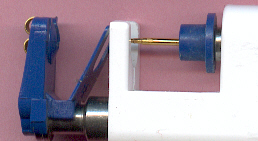Ear piercing instrument
Ear piercing instrument
An ear piercing instrument is a device used to create a hole in the earlobe or other parts of the ear for the purpose of inserting earrings or other types of body jewelry. These instruments are commonly used in body modification practices and can be found in various forms, including manual and powered devices.
Types of Ear Piercing Instruments[edit | edit source]
There are several types of ear piercing instruments, each with its own method of operation and application:
Piercing Gun[edit | edit source]
A piercing gun is a handheld device that uses a spring-loaded mechanism to quickly drive a stud through the earlobe. This type of instrument is widely used in retail settings such as jewelry stores and mall kiosks. Piercing guns are often favored for their speed and ease of use, but they have been criticized for potential tissue damage and increased risk of infection.
Needle[edit | edit source]
A piercing needle is a hollow needle used by professional piercers in body piercing studios. The needle creates a clean hole by removing a small piece of tissue, which can reduce the risk of trauma and infection compared to piercing guns. Piercing needles are typically used for more complex piercings, such as those in the cartilage.
Dermal Punch[edit | edit source]
A dermal punch is a specialized instrument used to create larger holes in the ear, often for the purpose of stretching the piercing. This tool is commonly used in body modification practices and requires a high level of skill to use safely.
Procedure[edit | edit source]
The procedure for ear piercing varies depending on the instrument used. Generally, the process involves the following steps:
- Preparation: The area to be pierced is cleaned with an antiseptic solution to reduce the risk of infection.
- Marking: The desired location for the piercing is marked with a sterile pen.
- Piercing: The instrument is used to create the hole, and the initial jewelry is inserted.
- Aftercare: The pierced area is cleaned, and aftercare instructions are provided to ensure proper healing.
Aftercare[edit | edit source]
Proper aftercare is crucial to prevent complications such as infection, keloids, and allergic reactions. Common aftercare practices include:
- Cleaning the piercing with a saline solution.
- Avoiding touching the piercing with dirty hands.
- Avoiding swimming in pools or other bodies of water that may contain bacteria.
- Following any additional instructions provided by the piercer.
Complications[edit | edit source]
While ear piercing is generally safe, complications can occur. These may include:
- Infection: Bacterial infections can occur if the piercing is not properly cared for.
- Allergic reaction: Some individuals may have an allergic reaction to the metal in the jewelry.
- Keloid formation: Overgrowth of scar tissue can occur, leading to keloids.
- Tissue damage: Improper use of piercing instruments can cause damage to the ear tissue.
History[edit | edit source]
The practice of ear piercing dates back thousands of years and has been found in various ancient cultures. Ear piercing has been used for cultural, religious, and aesthetic reasons throughout history.
See also[edit | edit source]
References[edit | edit source]
External links[edit | edit source]
Search WikiMD
Ad.Tired of being Overweight? Try W8MD's physician weight loss program.
Semaglutide (Ozempic / Wegovy and Tirzepatide (Mounjaro / Zepbound) available.
Advertise on WikiMD
|
WikiMD's Wellness Encyclopedia |
| Let Food Be Thy Medicine Medicine Thy Food - Hippocrates |
Translate this page: - East Asian
中文,
日本,
한국어,
South Asian
हिन्दी,
தமிழ்,
తెలుగు,
Urdu,
ಕನ್ನಡ,
Southeast Asian
Indonesian,
Vietnamese,
Thai,
မြန်မာဘာသာ,
বাংলা
European
español,
Deutsch,
français,
Greek,
português do Brasil,
polski,
română,
русский,
Nederlands,
norsk,
svenska,
suomi,
Italian
Middle Eastern & African
عربى,
Turkish,
Persian,
Hebrew,
Afrikaans,
isiZulu,
Kiswahili,
Other
Bulgarian,
Hungarian,
Czech,
Swedish,
മലയാളം,
मराठी,
ਪੰਜਾਬੀ,
ગુજરાતી,
Portuguese,
Ukrainian
Medical Disclaimer: WikiMD is not a substitute for professional medical advice. The information on WikiMD is provided as an information resource only, may be incorrect, outdated or misleading, and is not to be used or relied on for any diagnostic or treatment purposes. Please consult your health care provider before making any healthcare decisions or for guidance about a specific medical condition. WikiMD expressly disclaims responsibility, and shall have no liability, for any damages, loss, injury, or liability whatsoever suffered as a result of your reliance on the information contained in this site. By visiting this site you agree to the foregoing terms and conditions, which may from time to time be changed or supplemented by WikiMD. If you do not agree to the foregoing terms and conditions, you should not enter or use this site. See full disclaimer.
Credits:Most images are courtesy of Wikimedia commons, and templates, categories Wikipedia, licensed under CC BY SA or similar.
Contributors: Prab R. Tumpati, MD





